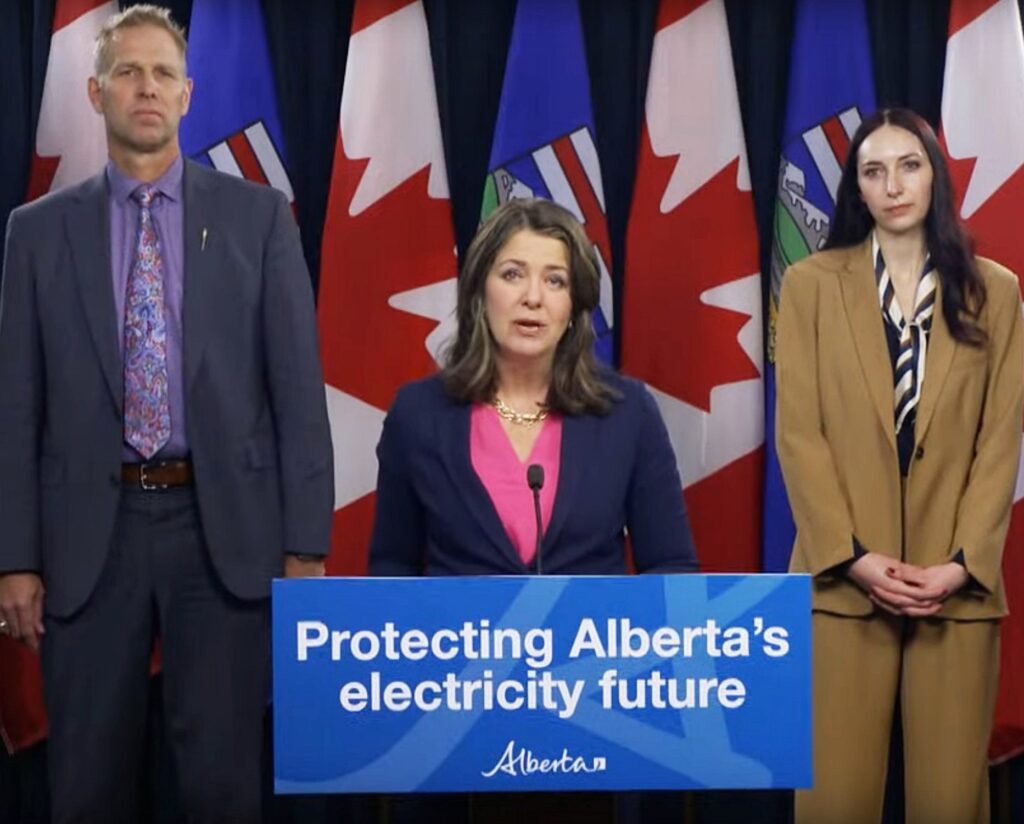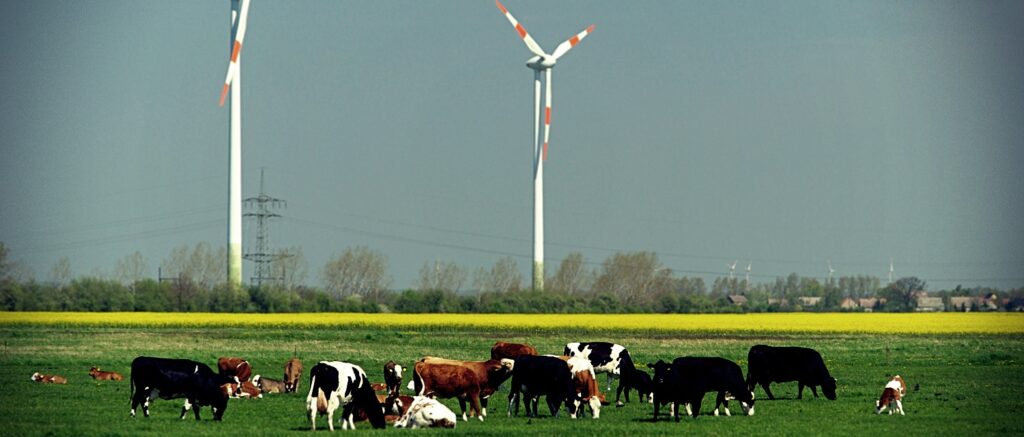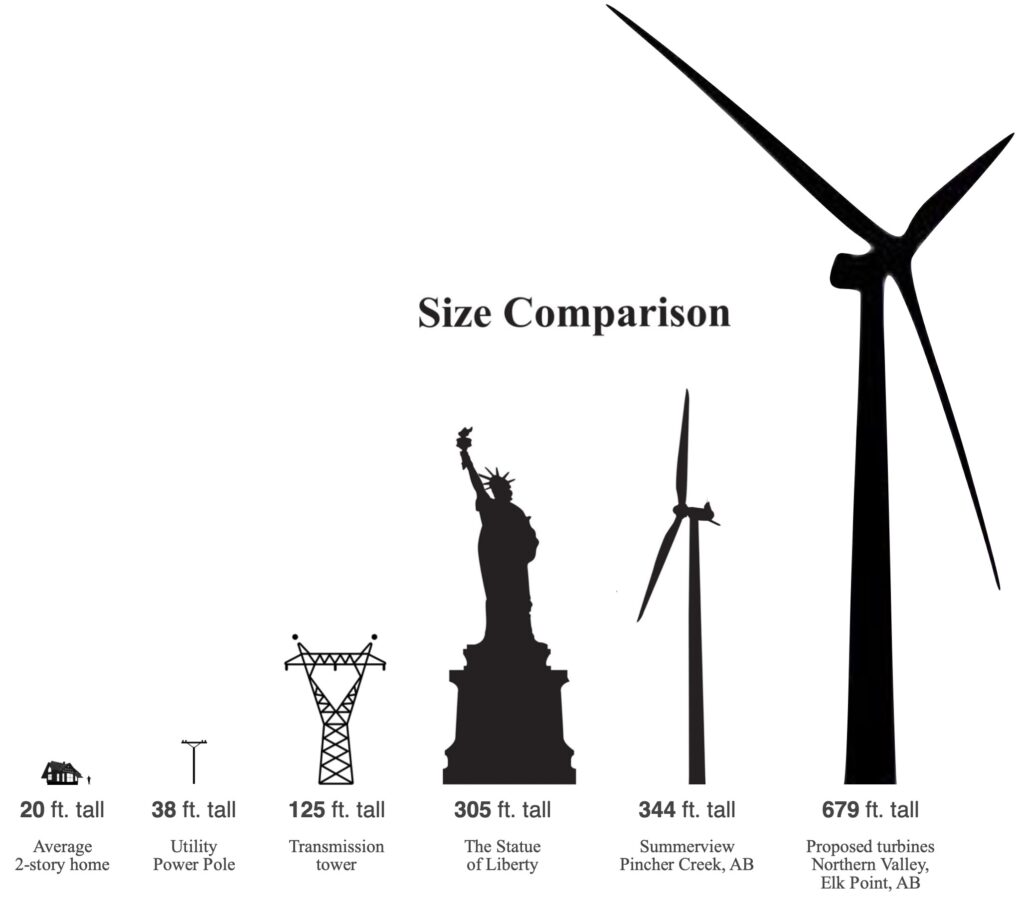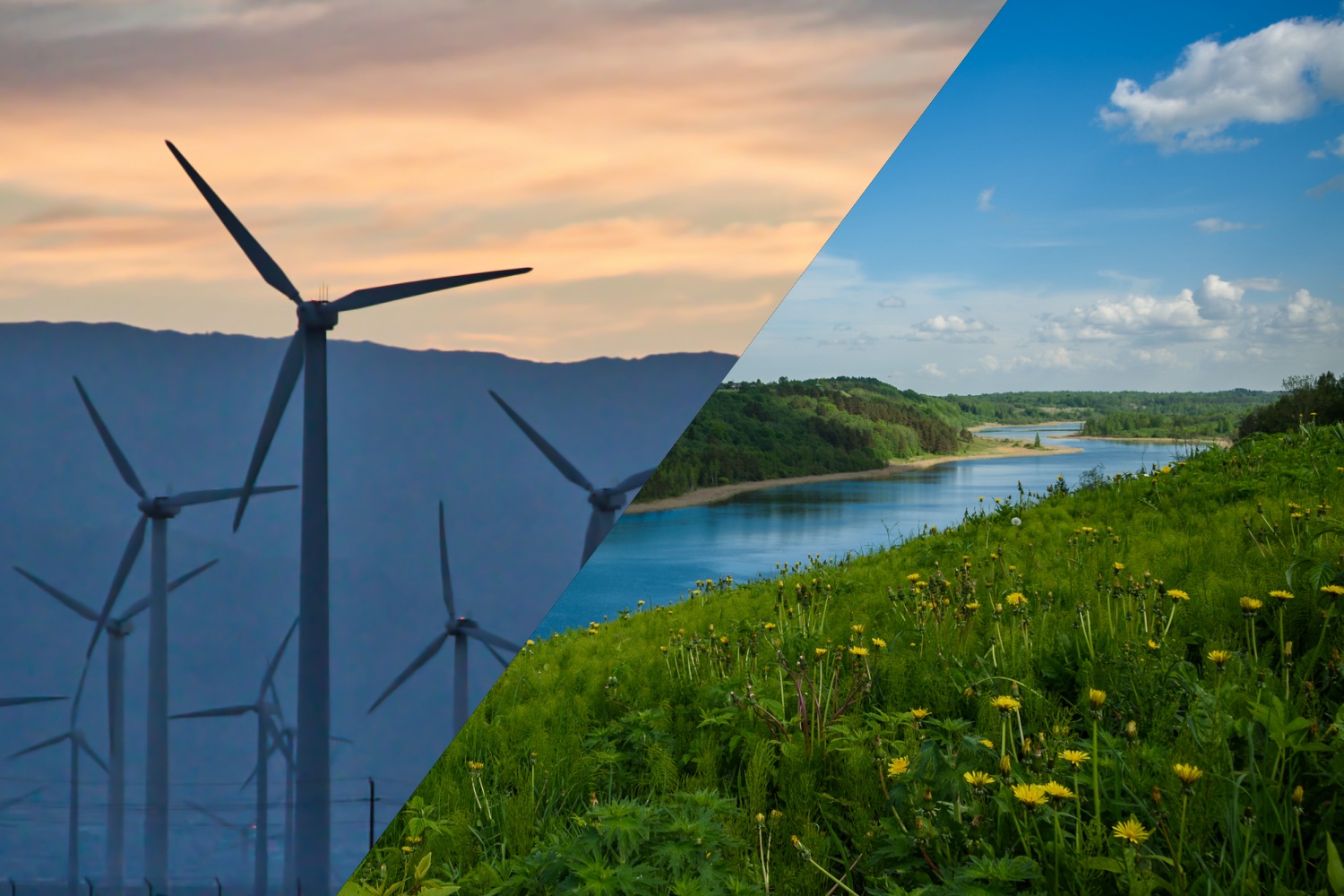Following a 7 month pause on approval of renewable energy projects, the Alberta government has taken a serious though somewhat ambiguous step forward to mitigating the widespread unprecedented impacts of wind and other renewable projects on the province’s landscape.
…growing our renewable energy industry must happen in well-defined and responsible ways. That wasn’t happening… We need to ensure that we’re not sacrificing our future agricultural yields, or tourism dollars, or breath-taking viewscapes to rush renewable’s developments through. And it will keep Albertans at the forefront of our policy.
Premier Danielle Smith, Press Conference, February 28, 2024; YouTube
Smith flatly stated that renewable energy is not a “silver bullet” given their unreliability and unaffordability, since they continue to drive up Albertans’ utility bills in their wake.

Going forward, she said the Alberta Utilities Commission (AUC) will take an “agriculture first” approach when evaluating farmlands for potential renewable projects. As such, Alberta will no longer permit renewable energy projects on Class 1 or 2 soils. But she immediately added the caveat: “unless the proponent can demonstrate the ability for both crops and livestock to co-exist with the renewable generation project.”
However, Minister of Affordability and Utilities, Nathan Neudorf, further qualified their declaration: “Let me be clear, there will be no blanket bans on specific types of land. Instead, we’re being responsible by insuring that renewable energy projects do not sterilize agricultural lands. That’s why proponents must demonstrate that agriculture, both crops and livestock, are able to co-exist with developments on LSRS Class 1 and Class 2 lands.”
However, how do you define “sterilize”?
Wind Concerns has pointed out numerous studies showing how industrial wind factories actually cause surface warming,1 cause soil to dry out,2 and even force the evacuation of earthworms.3 And efforts to restore roads and land surrounding turbine sites are notoriously poor.4 Moreover, the disturbing destruction of bats and insects at turbine sites has an indirect impact on surrounding croplands that rely upon these creatures for cross-seeding and pollination. Will the AUC take this into consideration or only consider the direct loss of acres?
And when it comes to whether or not livestock or even humans, for that matter, can “co-exist” with these developments, the science continues to say “no.” In a study now being cited in court cases,5 the authors concluded that:
Applying the Bradford Hill’s criteria to the IWT [industrial wind turbine]-related clinical, biological, and experimental data demonstrates that the exposure to IWTs is associated with an increased risk of AHEs [adverse health effects]. This analysis concludes that living or working near IWTs can result in AHEs in both people and animals.
September 2021, “Wind turbines and adverse health effects: Applying Bradford Hill’s criteria for causation“

That study cited “AHEs in animals that have been attributed to proximity of IWTs include reproduction and teratogenic effects in the USA, Canada, Denmark, and Japan; deformities in Portugal; mortalities in Canada, France, and Taiwan; stress in the UK; and other effects.”6
Premier Smith also announced a new requirement for energy corporations to provide a bond or security paid to the Government to ensure the proper reclamation of project sites — this, in order to avoid a similar “orphaned well” crisis the government continues to face whereby oil companies have abandoned well sites that have yet to be properly reclaimed.
Smith also announced that municipalities are being given a voice in what has thus far been a one-sided, unbalanced decision making process. They will now have the right to intervene in AUC hearings and be refunded their costs. This means that the AUC will have to justify to the public why, for instance, they would completely ignore municipal interests and the will of the people, as they have done in the past.
The Premier also briefly touched on the discussion of cost allocation regarding transmission lines, hinting that renewable energy proponents should expect changes on who will be responsible for those costs.
35 km Buffer Zone
But perhaps the biggest restriction the government has called for is a 35km buffer zone around “protected areas” and “pristine landscapes.”
We will establish buffer zones of a minimum of 35km around protected areas and other pristine viewscapes as designated by the Province. New wind projects will no longer be permitted within those buffer zones, and other proposed developments, located within the buffer zones, may be subject to a visual impact assessment before approval.
Albertans have been vocal that they don’t want large-scale developments to interfere with our province’s most beautiful natural features. You cannot build wind turbines the size of the Calgary tower in front of a UNESCO World Heritage site; or on Nose Hill; or in your neighbor’s backyard. We have a duty to protect the natural beauty and communities of our province.
Premier Danielle Smith, Press Conference, February 28, 2024; YouTube

Neudorf stated that it was due to the “vertical footprint” of turbines that they are excluded from these zones.
This immediately begs the question: what is considered a “pristine viewscape” and which are the “protected areas”? In response, Minister Neudorf cited the foothills and mountains as an example. However, what about the pristine viewscape of the North Saskatchewan River, also slated for an industrial wind project near Elk Point? What about Provincial Parks and heritage sites? And how will the government prevent wind companies and landowners from erecting turbines in their “neighbor’s backyard”? These are crucial questions that should not be left to the discernment of the AUC and biased green corporate lawyers, but to the municipalities and people who occupy and visit these regions that also generate tourism and recreation dollars.
Still, the acknowledgement of the harm industrial wind factories cause to the beauty of our landscapes is a brave and necessary step by the Alberta Government. After all, how can you claim to save the planet while wrecking it?7
A Step in the Right Direction
Unquestionably, the province has taken a step in the right direction to see to a more responsible implementation of alternative energy sources. Until now, it’s been a “free-for-all”, and almost solely on the backs of rural Albertans. And no doubt, Premier Smith will be dragged through the media and name-called, as ususual, for “destroying the planet”, being “pro-oil”, “far right”, yadyada.8 But it’s the radical agenda of Prime Minister Trudeau and his Environment Minister, Steven Guilbeault, that is truly dangerous. And it’s about time that steps are taken to diffuse the hot air from both Ottawa — and wind factories.9
Still, there are important unanswered questions in terms of just where Big Wind will be permitted in the province. And still, no recognition at all of the now proven health impacts of putting wind factories next to human populations.10 Wind Concerns still believes that the best option, both environmentally and economically, is to simply declare a moratorium once and for all on the veritable scam that industrial wind factories are — as Ontario did in 2018.11
The Liberals’ disastrous energy policy, the Green Energy Act, and the lucrative subsidies given to “renewables” – especially inefficient wind energy – have cost our province dearly. Thanks to heavily-subsidized and over-priced wind power that we do not need, electricity rates have skyrocketed. People across our province are faced with the highest electricity prices in North America. This is killing our economy and crippling the hard-working people of rural Ontario. It is disgraceful that many are being forced to choose between heating and eating. Situations like the contamination of formerly pristine water in wells in Chatham Kent, for example, are completely unacceptable. Families having to abandon their homes because of wind developers is unacceptable. As Premier, I would create a new energy plan for Ontario that puts health and safety first….
Letter from Doug Ford, candidate for Ontario Premier, to North American Platform Against Windpower, March 1, 2018 shortly before he was elected, and declared a moratorium on wind energy
But this is a huge step in the right direction, and at least some Albertans are breathing a little easier today.
- cf. Oh, Irony of Ironies[↩]
- “Wind farms lead to ‘significant’ decrease in soil moisture, study“[↩]
- “Small Victims: Wind Turbines Drive Away Earthworms“[↩]
- https://web.archive.org/web/20061212033647/http://www.powernaturally.org:80/programs/wind/toolkit/7_visualimpactupfront.pdf[↩]
- cf. Supreme Court Win on “noise disturbance”[↩]
- see study footnotes for references[↩]
- see The Forgotten Resource: Beauty[↩]
- see Hot Air Behind the Wind[↩]
- cf. Hot Air Behind the Wind[↩]
- cf. Turbine Sickness: How Far Away is Safe?[↩]
- see Ontarian’s Turbine Nightmare Continues[↩]
Mark Mallett is a former award-winning reporter with CTV Edmonton and an independent researcher and author. His family homesteaded between Vermilion and Cold Lake, Alberta, and now resides in the Lakeland region. Mark is Editor in Chief of Wind Concerns.



This was a big step for Premier Smith, but I agree it doesn’t address any health concerns for humans nor animal species. In that regard I feel she didn’t listen to all Albertans but also realizing she will need to deal with the fall out from corporate media. Until the subsidies end, this issue will continue to be a plague for Alberta – only a complete ban will suffice!
Thank you for all you’re doing for our country. We are fighting this in Newfoundland since our politicians just lifted the wind moratorium.
These politicians are caving to political pressure, not to common sense. Continue to put the facts in front of their faces; continue to show them the environmental and economic devastation of wind factories all over the world. Search our website and categories for the research we’ve done (for you, as well, to be honest). We know the heartache you are going through and hope this website will be a helpful resource to the good people on “The Rock” who don’t deserve to have the stunning beauty of your province destroyed by politicans, and your generational homes and views destroyed by the greed of “Green” energy corporations. Don’t give up!